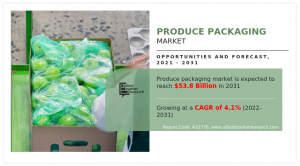Produce Packaging Market Size, Share and Industry Analysis 2031
global produce packaging market size was valued at $35.6 billion in 2021, and is projected to reach $53.8 billion by 2031, growing at a CAGR of 4.1%
PORTLAND, UNITED STATES, UNITED STATES, May 23, 2023 /EINPresswire.com/ -- Produce packaging is a market segment that has seen immense growth over the last few years. Produce packaging is the process of making, storing, and shipping produce for retail stores or restaurants. This market segment has grown rapidly over the past decade, with the increasing demand for organic and sustainably grown produce. Knowing the details of produce packaging, its advantages, and its downside is essential for businesses that want to stay competitive in the produce industry.
Download Free Sample PDF Now (150+Pages with More Insight)- https://www.alliedmarketresearch.com/request-sample/32226
History
Produce packaging has been used since ancient times. The Chinese, Egyptians, and Greeks all used techniques of packing and storing fruits, vegetables, and grains. During the 19th century, produce packaging became more advanced. Innovations such as canning, freezing, and, later, modified atmosphere packaging (MAP) increased the shelf life of produce and reduced spoilage. The creation of plastic and foam packaging also helped to further extend the life of produce, though it was not until the last few decades that these materials began to be used in earnest.
Make a Purchase Inquiry - https://www.alliedmarketresearch.com/purchase-enquiry/32226
Market Overview
The global produce packaging market is expected to be valued at around $99.5 billion by 2026, growing at a CAGR of 4.1% during the forecast period. The growing awareness of healthy eating among consumers, advancements in technology, and the availability of a varied range of packaging materials provide an impetus to the growth of the produce packaging market. The rising demand for sustainable packaging solutions is also helping to drive this growth forward.
Types of Packaging
Produce packaging is available in a variety of forms. Common types of packaging materials include plastic, paper, cardboard, and foam. Each type of packaging material has its own advantages and disadvantages. Plastic packaging offers strength, durability, and affordability, while paper and cardboard packaging provide more environmentally friendly options. Foam packaging is often used to protect delicate produce, while modified atmosphere packaging (MAP) can help to extend the shelf life of fresh fruits and vegetables.
Download Free Sample PDF Now (150+Pages with More Insight)- https://www.alliedmarketresearch.com/request-sample/32226
Advantages
Produce packaging provides many advantages, including the prevention of spoilage and contamination, longer shelf life, and improved transportation and storage. It can also be used to preserve the flavor and nutritional value of produce. In addition, efficient packaging can help to reduce costs for businesses, since it requires less manpower to handle and store produce packs. Furthermore, packaging materials such as plastics and foams are also recyclable, making them more sustainable options.
Disadvantages
One of the main drawbacks of produce packaging is the cost. While packaging materials are often cheaper than traditional forms of storage, such as refrigeration, the cost of efficient packaging can still be quite high. Furthermore, packaging material can be hazardous or even toxic if not handled correctly. Finally, the production and disposal of plastic and foam packaging can have a negative impact on the environment.
Conclusion
Produce packaging is an important part of the produce industry. The advantages of using the right type of packaging material are numerous, including the prevention of spoilage and contamination, longer shelf life, and improved transportation and storage. However, there are also some drawbacks to consider--such as cost and environmental impact--before deciding on the right type of packaging material for your produce. Understanding the market, its advantages and disadvantages, and the types of packaging materials available can help businesses to make the most informed decision about their produce packaging needs.
David Correa
Allied Analytics LLP
+15038946022 ext.
email us here
Legal Disclaimer:
EIN Presswire provides this news content "as is" without warranty of any kind. We do not accept any responsibility or liability for the accuracy, content, images, videos, licenses, completeness, legality, or reliability of the information contained in this article. If you have any complaints or copyright issues related to this article, kindly contact the author above.

